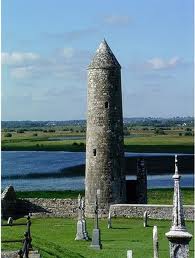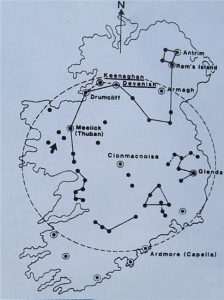Tuatha de Danaan
Tuatha De Danaan
The Tuatha Dé Danaan according to tradition as recorded in the Book of Invasions (Lebor Gabála Érenn) were the fifth group to ‘settle’ in Ireland. The name translates as ‘the people of the goddess Danu’.
The pre-Hellenic Greeks were known as the Danai and were, according to an Egyptian source, the descendants of Danaus. Furthermore, the Danai have been linked with the legendary Tuatha dé Danaan of Ireland as well as the Shardana of Sardinia.
Egerton Sykes thought that the Tuatha de Danaan were refugees from Atlantis, an idea he expressed in his 1949 edition of Ignatius Donnelly’s Atlantis.
Another popular belief is that the Tuatha dé Danaan were descendants of the Hebrew tribe of Dan. Walter Baucum and in particular Yair Davidiy have written extensively on the people of Dan and their possible migration routes. Leonardo Melis also links the Shardana with the lost tribe of Dan as well as the Tuatha Dé Danaan.
In The Megalithic Odyssey [1797] Christian O’Brien proposed that an order of Sumerian ‘Sages’ brought advanced knowledge to Egypt, Britain and Ireland and further afield. Along the way, they or their leaders are remembered by different names, Osiris, Tuatha dé Danann, Druids or in Mexico as Quetzalcoatl!
>David Hatcher Childress referred to the Tuatha de Danaan in Lost Cities of Atlantis, Ancient Europe & the Mediterranean [620], listing a range of theories, often conflicting, relating to their origins. Unexpectedly, Robert Charroux was of the opinion that they were Mayans from Central America [p425]. Childress relates that Jacques Valleé proposed that the de Danaan were ‘interdimensional fairy-folk that arrived in glowing UFOs’! He also quotes the equally entertaining comments of N.L. Thomas, who wrote that ‘the Tuatha were a people possessed of magic wonders, the supreme artists of wizardry, who came to Ireland, not by ship, but descended from the northern sky [1952.81]. Childress, apparently beguiled by this added “it is fascinating to think that the Tuatha de Danaan arrived by airships, rather than boats. This may be merely a legend, or perhaps it actually chronicles the landing of ancient airships in Ireland.” I think it is far more likely that they arrived on flying pigs.<
Murias
Murias according to Egerton Sykes was an Atlantean city situated near Bimini, which was destroyed when sea levels rose around 10,000 BC(a).
There is an Irish tradition that names Murias as one of the four cities of the Tuatha dé Danaan(b), who came to Ireland a thousand years before the Celts.
The pre-Hellenic Greeks were known as the Danai and were, according to an Egyptian source, the descendants of Danaus. Furthermore, the Danai have been linked with the legendary Tuatha dé Danaan of Ireland as well as the Shardana of Sardinia, who are thought to be part of the Sea Peoples.
A popular belief is that the Tuatha dé Danaan were descendants of the Hebrew tribe of Dan. Walter Baucum(c) and in particular Yair Davidiy(d) have written extensively on the people of Dan and their possible migration routes.
(a) Atlantis, A New Concept. Pt.1, Atlantis May-June, 1974
(b) https://en.wikipedia.org/wiki/Four_Treasures_of_the_Tuatha_D%C3%A9_Danann
Melis, Leonardo
Leonardo Melis (1949- ) was born in Sardinia. He has written[478] extensively  on the Shardana, one of the Sea Peoples, who are usually accepted as coming from Sardinia. It is to be hoped that Melis’ book will be published in English before long. Melis also links the Shardana with the lost tribe of Dan and also the Tuatha DeDanaan who invaded Ireland in the dim and distant past. Melis continues to have his books supported by a website(a) with an English translation.
on the Shardana, one of the Sea Peoples, who are usually accepted as coming from Sardinia. It is to be hoped that Melis’ book will be published in English before long. Melis also links the Shardana with the lost tribe of Dan and also the Tuatha DeDanaan who invaded Ireland in the dim and distant past. Melis continues to have his books supported by a website(a) with an English translation.
Melis identifies the mythological Tirrenide with the anciently combined Corsica and Sardinia. He is also highly critical of Sergio Frau’s Atlantis in Sardinia theory(b).
>(a) English (archive.org)<
(b) See:Archive 2511
O’Brien, Henry
Henry O’Brien (1807-1835) was an Irishman born in Co. Kerry who only lived a short twenty-eight years. In 1830 the Royal Irish Academy  sponsored a competition for the most appropriate essay, which explained the origin and purpose of Ireland’s Round Towers. The winner’s prize went to George Petrie. O’Brien’s thesis was considered too radical and so, controversially, O’Brien was only awarded a consolation prize of £20.
sponsored a competition for the most appropriate essay, which explained the origin and purpose of Ireland’s Round Towers. The winner’s prize went to George Petrie. O’Brien’s thesis was considered too radical and so, controversially, O’Brien was only awarded a consolation prize of £20.
His work was published in 1834[124] and republished in more recent years with new but totally misleading titles that imply that the author linked Ireland with Atlantis[125][126]. The book has nothing to do with Atlantis or Plato but is an attempt to attribute the building of the famous round towers of Ireland to the Tuatha dé Danann who invaded Ireland in the distant mists of time and whom O’Brien contended came originally from Persia. The book is written in the turgid style of the period and today would not be considered an ‘easy read’. However, his book can now be read or downloaded from the internet for free(a).
While O’Brien’s theory may appear outlandish today, the 21st century has continued to generate revolutionary  theories regarding our round towers, relating to both their function and location. American professor Phil Callahan>>(1923-2017)<<, after studying a map of Ireland showing the towers he realised that “the towers formed a star map of the northern night sky at the time of the winter solstice.” However he goes further(b)(c), claiming that “Soils around round towers are highly paramagnetic and enjoy great fertility.”
theories regarding our round towers, relating to both their function and location. American professor Phil Callahan>>(1923-2017)<<, after studying a map of Ireland showing the towers he realised that “the towers formed a star map of the northern night sky at the time of the winter solstice.” However he goes further(b)(c), claiming that “Soils around round towers are highly paramagnetic and enjoy great fertility.”
Callahan believes that the Irish towers act as wave-guides or aerials for extra-low-frequency (ELF) radiation from high above Earth ( Schumann radiation) and the sun . Vital to our health, ELF waves are able to penetrate water and soil, unlike higher frequencies of radiation. To amplify incoming ELF, towers must be paramagnetic, and the effect is enhanced even more when paramagnetic and diamagnetic (i.e. weakly repelled by a magnet) materials are sandwiched together. Callahan’s theories are more fully explored in his Ancient Mysteries, Modern Vision[1528].
(a) https://www.gutenberg.org/ebooks/42538
(b)THE ENIGMA OF THE TOWERS (whale.to) *
(c) Philip Callahan and The Round Towers | MalagaBay (archive.org)
Evaemon (Euaemon) (L)
Evaemon (Euaemon) is the name of one of the fourth pair (with Ampheres) of twins who became the first kings of Atlantis.
Frank Joseph[104] identifies Euaemon with the ‘pre-Celtic’ king of Ireland, Eremon. This somewhat incorrect as the Milesians are generally accepted as having been Celtic. Eremon was one of eight Milesian brothers who invaded Ireland from Spain and defeated the Tuatha dé Danaan. It is interesting that Eremon had a brother, Eber Finn, with whom he shared control of Ireland, with Eber ruling the south and Eremon ruling the north. This arrangement was short-lived as they fought against each other leading to Eber’s death and Eremon ruling a united Ireland.
